Products
-
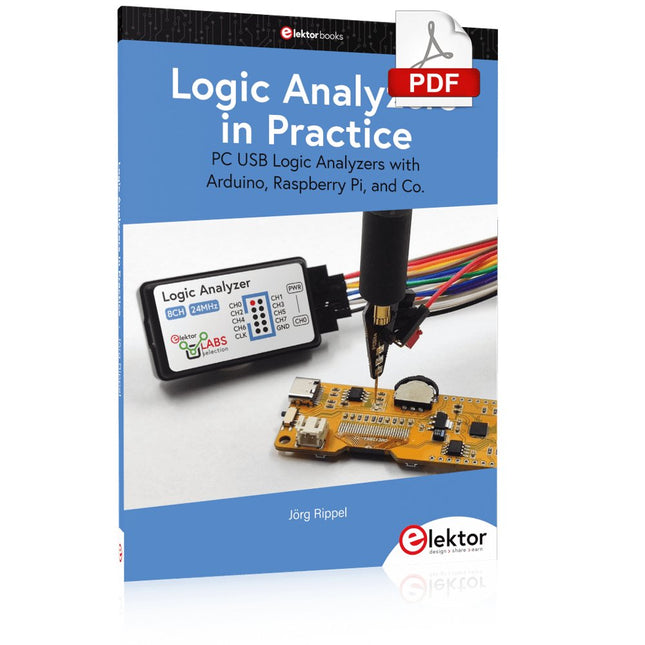
Elektor Digital Logic Analyzers in Practice (E-book)
PC USB Logic Analyzers with Arduino, Raspberry Pi, and Co. Step-by-step instructions guide you through the analysis of modern protocols such as I²C, SPI, UART, RS-232, NeoPixel, WS28xx, HD44780 and 1-Wire protocols. With the help of numerous experimental circuits based on the Raspberry Pi Pico, Arduino Uno and the Bus Pirate, you will learn the practical application of popular USB logic analyzers. All the experimental circuits presented in this book have been fully tested and are fully functional. The necessary program listings are included – no special programming or electronics knowledge is required for these circuits. The programming languages used are MicroPython and C along with the development environments Thonny and Arduino IDE. This book uses several models of flexible and widely available USB logic analyzers and shows the strengths and weaknesses of each price range. You will learn about the criteria that matter for your work and be able to find the right device for you. Whether Arduino, Raspberry Pi or Raspberry Pi Pico, the example circuits shown allow you to get started quickly with protocol analysis and can also serve as a basis for your own experiments. After reading this book, you will be familiar with all the important terms and contexts, conduct your own experiments, analyze protocols independently, culminating in a comprehensive knowledge set of digital signals and protocols.
€ 29,95
Members € 23,96
-

Loomia Loomia Double Backlit User Interface
Double Backlit User Interface: The dual backlit button is just like the single backlit button, but twice the fun! Use this component when you need to operate something up and down, or right to left. Using cut-out vinyl, you can create icons and stickers on fabric that show your users button functionality. Features Component: 4.6 x 6.3" Individual Button Size: 1" radius circle Press Durability: Up to 10,000 presses under 5lbf LED Voltage: 5 V
€ 54,95€ 39,95
Members identical
-

Loomia Loomia Mega Pressure Matrix
Like the mini pressure sensor, but bigger! Our 3x3 mega pressure matrix has 6 leads, allowing you to map which point you are at in the 3x3 matrix and get a pressure mapping over a surface. Each area has an analog readout that varies depending on the weight of the item on the pressure sensor. Generally, sensor values will read from 500 Kohms to 100 ohms depending on the force put onto the sensor. Features Component: 5 x 6.5" Sensing Area 3.0" Square Thickness: Approx 20 mils
-

Loomia Loomia Single Backlit Button
The single backlit button is a simple mechanical switch that comes with an LED inside. When you press the button, the circuit is completed, driving your pin high or low. Use the embedded LED to make a glowing power icon, logo , or whatever suits your fancy. Features Press durability: Up to 10,000 times pressing under 5lbf (22.24 N) LED Voltage: 5 V Component: 2" x 3" Individual (5,08 x 7,62 cm) Button Size: 1" radius circle (2,54 cm)
€ 49,95€ 29,95
Members identical
-

Loomia Loomia Single Pressure Sensor
The mini single pressure sensor gives you an analog read that maps to force on the sensor. The more you press, the lower the resistance goes, perfect for on-body pressure related sensing like ribcage expansion for breathing. This little one is small, but mighty, making it convenient for small surface area applications. Features Component: 2 x 1" Sensing area: .75 x .75" Thickness: Approx 20mils
-
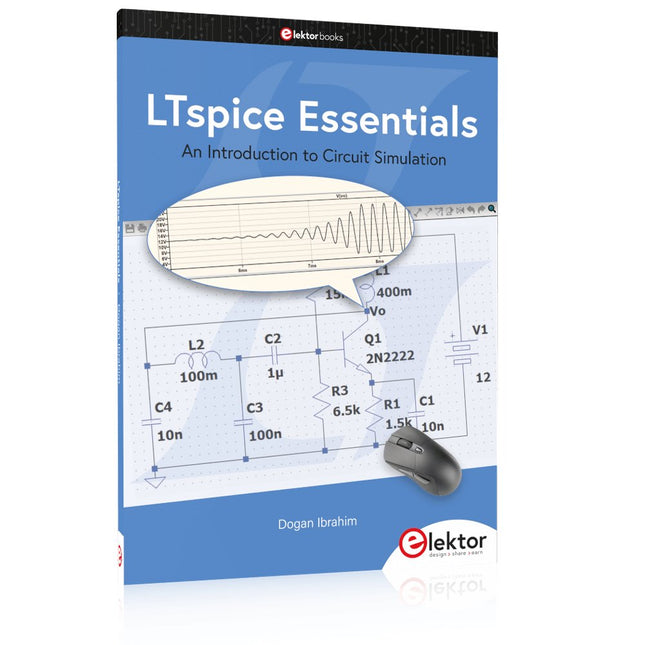
Elektor Publishing LTspice Essentials
An Introduction to Circuit Simulation LTspice, developed by Analog Devices, is a powerful, fast, and free SPICE simulator, schematic capture, and waveform viewer with a large database of components supported by SPICE models from all over the world. Drawing a schematic in LTspice is easy and fast. Thanks to its powerful graphing features, you can visualize the voltages and currents in a circuit, and also the power consumption of its components and much more. This book is about learning to design and simulate electronic circuits using LTspice. Among others, the following topics are treated: DC and AC circuits Signal diodes and Zener diodes Transistor circuits including oscillators Thyristor/SCR, diac, and triac circuits Operational amplifier circuits including oscillators The 555 timer IC Filters Voltage regulators Optocouplers Waveform generation Digital logic simulation including the 74HC family SPICE modeling LTspice is a powerful electronic circuit simulation tool with many features and possibilities. Covering them all in detail is not possible in a book of this size. Therefore, this book presents the most common topics like DC and AC circuit analysis, parameter sweeping, transfer functions, oscillators, graphing, etc. Although this book is an introduction to LTspice, it covers most topics of interest to people engaged in electronic circuit simulation. The book is aimed at electronic/electrical engineers, students, teachers, and hobbyists. Many tested simulation examples are given in the book. Readers do not need to have any computer programming skills, but it will help if they are familiar with basic electronic circuit design and operation principles. Readers who want to dive deeper can find many detailed tutorials, articles, videos, design files, and SPICE circuit models on the Internet. All the simulation examples used in the book are available as files at the webpage of this book. Readers can use these example circuits for learning or modify them for their own applications.
€ 39,95
Members € 35,96
-
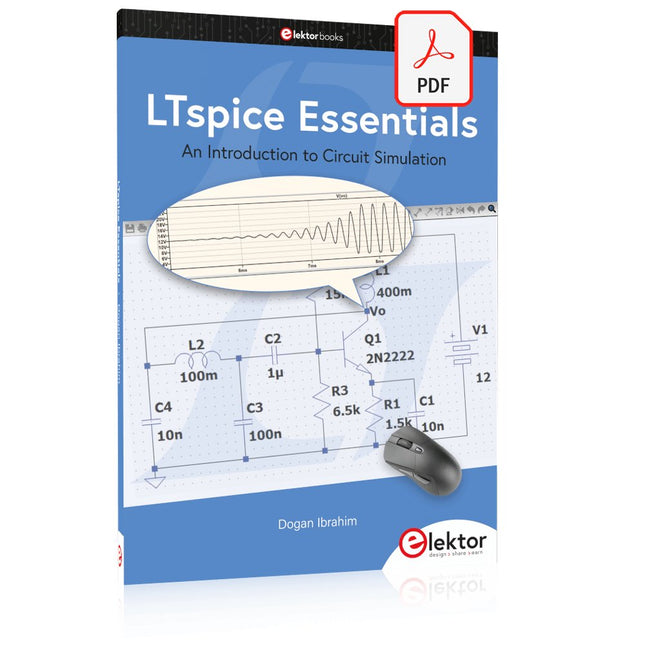
Elektor Digital LTspice Essentials (E-book)
An Introduction to Circuit Simulation LTspice, developed by Analog Devices, is a powerful, fast, and free SPICE simulator, schematic capture, and waveform viewer with a large database of components supported by SPICE models from all over the world. Drawing a schematic in LTspice is easy and fast. Thanks to its powerful graphing features, you can visualize the voltages and currents in a circuit, and also the power consumption of its components and much more. This book is about learning to design and simulate electronic circuits using LTspice. Among others, the following topics are treated: DC and AC circuits Signal diodes and Zener diodes Transistor circuits including oscillators Thyristor/SCR, diac, and triac circuits Operational amplifier circuits including oscillators The 555 timer IC Filters Voltage regulators Optocouplers Waveform generation Digital logic simulation including the 74HC family SPICE modeling LTspice is a powerful electronic circuit simulation tool with many features and possibilities. Covering them all in detail is not possible in a book of this size. Therefore, this book presents the most common topics like DC and AC circuit analysis, parameter sweeping, transfer functions, oscillators, graphing, etc. Although this book is an introduction to LTspice, it covers most topics of interest to people engaged in electronic circuit simulation. The book is aimed at electronic/electrical engineers, students, teachers, and hobbyists. Many tested simulation examples are given in the book. Readers do not need to have any computer programming skills, but it will help if they are familiar with basic electronic circuit design and operation principles. Readers who want to dive deeper can find many detailed tutorials, articles, videos, design files, and SPICE circuit models on the Internet. All the simulation examples used in the book are available as files at the webpage of this book. Readers can use these example circuits for learning or modify them for their own applications.
€ 32,95
Members € 26,36
-

Luckfox LuckFox Pico Mini B Linux Micro Development Board (with Headers)
LuckFox Pico Mini is a compact Linux micro development board based on the Rockchip RV1103 chip, providing a simple and efficient development platform for developers. It supports a variety of interfaces, including MIPI CSI, GPIO, UART, SPI, I²C, USB, etc., which is convenient for quick development and debugging. Features Single-core ARM Cortex-A7 32-bit core with integrated NEON and FPU Built-in Rockchip self-developed 4th generation NPU, features high computing precision and supports int, int8, and int16 hybrid quantization. The computing power of int8 is 0.5 TOPS, and up to 1.0 TOPS with int4 Built-in self-developed third-generation ISP3.2, supports 4-Megapixel, with multiple image enhancement and correction algorithms such as HDR, WDR, multi-level noise reduction, etc. Features powerful encoding performance, supports intelligent encoding mode and adaptive stream saving according to the scene, saves more than 50% bit rate of the conventional CBR mode so that the images from camera are high-definition with smaller size, double the storage space Built-in RISC-V MCU supports low power consumption and fast start-up, supports 250 ms fast picture capture and loading Al model library at the same time to realize face recognition "in one second" Built-in 16-bit DRAM DDR2, which is capable of sustaining demanding memory bandwidths Integrated with built-in POR, audio codec and MAC PHY Specifications Processor ARM Cortex-A7, single-core 32-bit CPU, 1.2 GHz, with NEON and FPU NPU Rockchip 4th-gen NPU, supports int4, int8, int16; up to 1.0 TOPS (int4) ISP Third-gen ISP3.2, up to 4 MP input at 30fps, HDR, WDR, noise reduction RAM 64 MB DDR2 Storage 128 MB SPI NAND Flash USB USB 2.0 Host/Device via Type-C Camera Interface MIPI CSI 2-lane GPIO Pins 17 GPIO pins Power Consumption Low power, RISC-V MCU for fast startup Dimensions 28 x 21 mm Downloads Wiki
€ 19,95€ 9,95
Members identical
-

Luckfox LuckFox Pico Ultra Linux Micro Development Board
The LuckFox Pico Ultra is a compact single-board computer (SBC) powered by the Rockchip RV1106G3 chipset, designed for AI processing, multimedia, and low-power embedded applications. It comes equipped with a built-in 1 TOPS NPU, making it ideal for edge AI workloads. With 256 MB RAM, 8 GB onboard eMMC storage, integrated WiFi, and support for the LuckFox PoE module, the board delivers both performance and versatility across a wide range of use cases. Running Linux, the LuckFox Pico Ultra supports a variety of interfaces – including MIPI CSI, RGB LCD, GPIO, UART, SPI, I²C, and USB – providing a simple and efficient development platform for applications in smart home, industrial control, and IoT. Specifications Chip Rockchip RV1106G3 Processor Cortex-A7 1.2 GHz Neural Network Processor (NPU) 1 TOPS, supports int4, int8, int16 Image Processor (ISP) Max input 5M @30fps Memory 256 MB DDR3L WiFi + Bluetooth 2.4GHz WiFi-6 Bluetooth 5.2/BLE Camera Interface MIPI CSI 2-lane DPI Interface RGB666 PoE Interface IEEE 802.3af PoE Speaker interface MX1.25 mm USB USB 2.0 Host/Device GPIO 30 GPIO pins Ethernet 10/100M Ethernet controller and embedded PHY Default Storage Medium eMMC (8 GB) Included 1x LuckFox Pico Ultra W 1x LuckFox PoE module 1x IPX 2.4G 2 db antenna 1x USB-A to USB-C cable 1x Screws pack Downloads Wiki
€ 39,95€ 19,95
Members identical
-
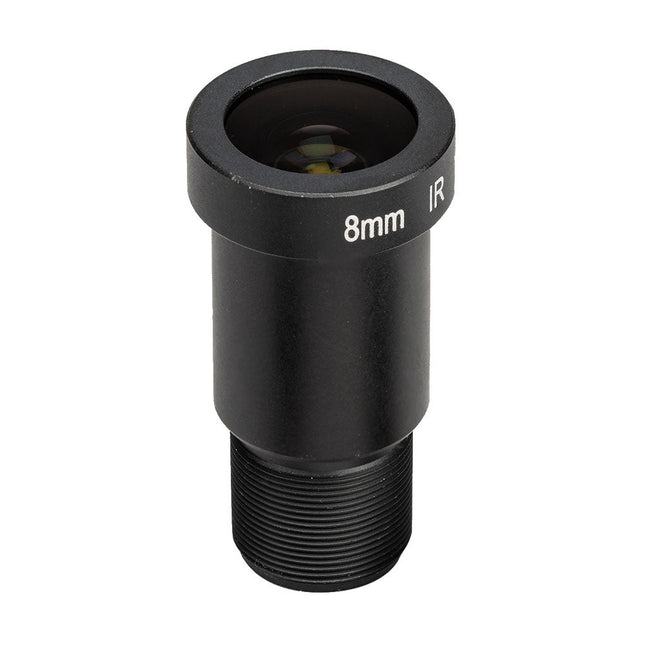
Raspberry Pi Foundation M12 Mount Lens (12 MP, 8 mm)
The M12 Mount Lens (12 MP, 8 mm) is ideal for use with the Raspberry Pi HQ Camera Module, offering sharp and detailed imaging for a wide range of applications.
€ 29,95€ 14,95
Members identical
-
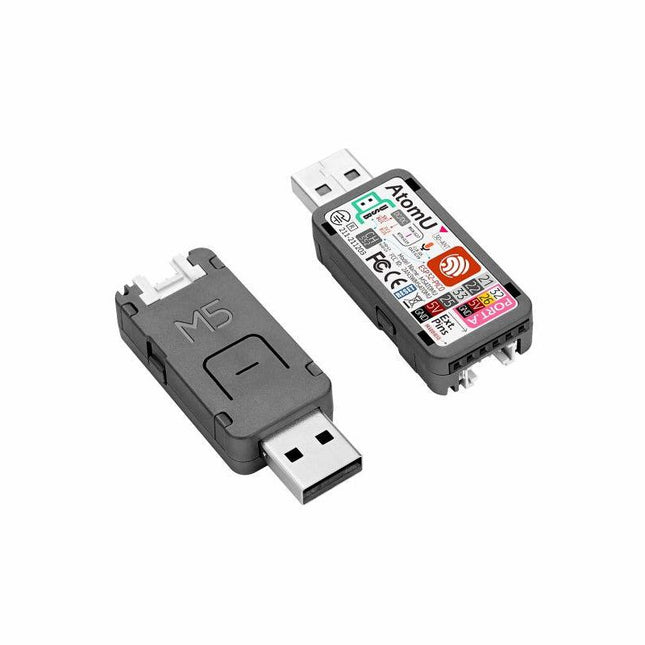
M5Stack M5Stack AtomU ESP32 Development Kit with USB-A
ATOM U is a compact low-power consumption speech recognition IoT development kit. It adopts an ESP32 chipset, equipped with 2 low-power Xtensa 32-bit LX6 microprocessors with the main frequency of up to 240 MHz. Built-in USB-A interface, IR emitter, programmable RGB LED. Plug-and-play, easy to upload and download programs. Integrated Wi-Fi and digital microphone SPM1423 (I2S) for the clear sound record. suitable for HMI, Speech-to-Text (STT). Low-code development ATOM U supports UIFlow graphical programming platform, scripting-free, cloud push; Fully compatible with Arduino, MicroPython, ESP32-IDF, and other mainstream development platforms, to quickly build various applications. High integration ATOM U contains a USB-A port for programming/power supply, IR emitter, programmable RGB LED x1, button x1; Finely tuned RF circuit, providing stable and reliable wireless communication. Strong expandability ATOM U is easy access to M5Stack's hardware and software system. Features ESP32-PICO-D4 (2.4GHz Wi-Fi dual mode) Integrated programmable RGB LED and button Compact design Built-in IR emitter Expandable pinout and GROVE port Development platform: UIFlow MicroPython Arduino Specifications ESP32-PICO-D4 240MHz dual core, 600 DMIPS, 520KB SRAM, 2.4G Wi-Fi Microphone SPM1423 Microphone sensitivity 94 dB SPL@1 KHz Typical value: -22 dBFS Microphone signal-to-noise ratio 94 dB SPL@1 KHz, A-weighted Typical value: 61.4 dB Standby working current 40.4 mA Support input sound frequency 100 Hz ~ 10 KHz Support PDM clock frequency 1.0 ~ 3.25 MHz Weight 8.4 g Product size 52 x 20 x 10 mm Downloads Documentation
€ 19,95€ 9,95
Members identical
-
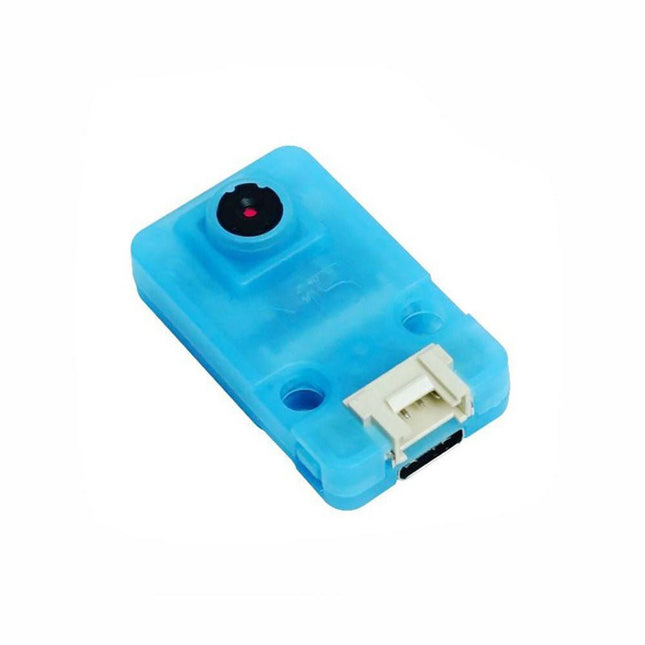
M5Stack M5Stack UnitV K210 AI Camera for Edge Computing (OV7740)
OV7740 is a AI Camera powered by Kendryte K210, an edge computing system-on-chip(SoC) with a dual-core 64bit RISC-V CPU and state-of-art neural network processor. Features Dual-Core 64-bit RISC-V RV64IMAFDC (RV64GC) CPU / 400Mhz(Normal) Dual Independent Double Precision FPU 8MiB 64bit width On-Chip SRAM Neural Network Processor(KPU) / 0.8Tops Field-Programmable IO Array (FPIOA) AES, SHA256 Accelerator Direct Memory Access Controller (DMAC) Micropython Support Firmware encryption support On-board Hardware: Flash: 16M Camera :OV7740 2x Buttons Status Indicator LED External storage: TF card/Micro SD Interface: HY2.0/compatible GROVE Applications Face recognition/detection Object detection/classification Obtain the size and coordinates of the target in real-time Obtain the type of detected target in real-time Shape recognition Video recorder Included 1x UNIT-V(include 20cm 4P cable and USB-C cable)
€ 49,95€ 24,95
Members identical
-

M5Stack M5Stamp Fly Quadcopter (with M5StampS3)
M5Stamp Fly is a programmable open-source quadcopter, featuring the StampS3 as the main controller. It integrates a BMI270 6-axis gyroscope and a BMM150 3-axis magnetometer for attitude and direction detection. The BMP280 barometric pressure sensor and two VL53L3 distance sensors enable precise altitude hold and obstacle avoidance. The PMW3901MB-TXQT optical flow sensor provides displacement detection. The kit includes a buzzer, a reset button, and WS2812 RGB LEDs for interaction and status indication. It is equipped with a 300 mAh high-voltage battery and four high-speed coreless motors. The PCB features an INA3221AIRGVR for real-time current/voltage monitoring and has two Grove connectors for additional sensors and peripherals. Preloaded with debugging firmware, the Stamp Fly can be controlled using an Atom Joystick via the ESP-NOW protocol. Users can choose between automatic and manual modes, allowing for easy implementation of functions like precise hovering and flips. The firmware source code is open-source, making the product suitable for education, research, and various drone development projects. Applications Education Research Drone development DIY projects Features M5StampS3 as the main controller BMP280 for barometric pressure detection VL53L3 distance sensors for altitude hold and obstacle avoidance 6-axis attitude sensor 3-axis magnetometer for direction detection Optical flow detection for hovering and displacement detection Buzzer 300 mAh high-voltage battery Current and voltage detection Grove connector expansion Specifications M5StampS3 ESP32-S3@Xtensa LX7, 8 MB Flash, WiFi, OTG\CDC support Motor 716-17600kv Distance Sensor VL53L3CXV0DH/1 (0x52) @ max 3 m Optical Flow Sensor PMW3901MB-TXQT Barometric Sensor BMP280 (0x76) @ 300-1100hPa 3-axis Magnetometer BMM150 (0x10) 6-axis IMU Sensor BMI270 Grove I²C+UART Battery 300mAh 1S high-voltage lithium battery Current/Voltage Detection INA3221AIRGVR (0x40) Buzzer Built-in Passive Buzzer @ 5020 Operating temperature 0-40°C Dimensions 81.5 x 81.5 x 31 mm Weight 36.8 g Included 1x Stamp Fly 1x 300 mAh high-voltage Lithium battery Downloads Documentation
-
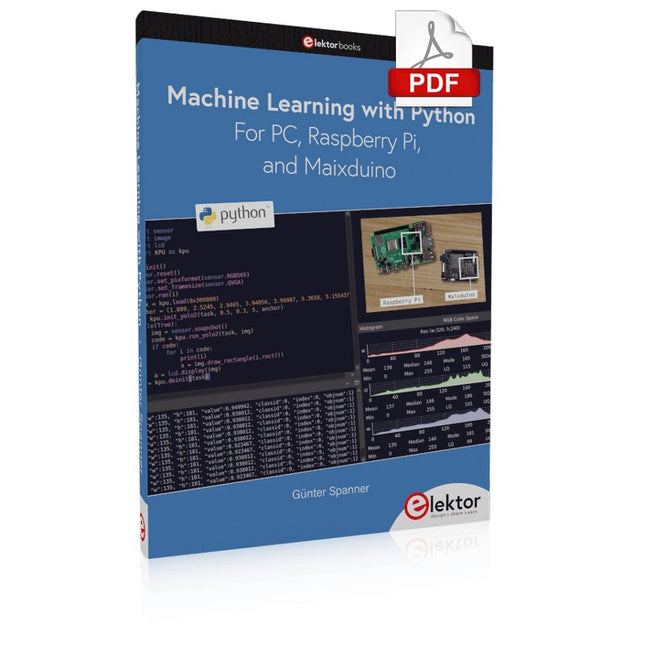
Elektor Digital Machine Learning with Python for PC, Raspberry Pi, and Maixduino (E-book)
Most people are increasingly confronted with the applications of Artificial Intelligence (AI). Music or video ratings, navigation systems, shopping advice, etc. are based on methods that can be attributed to this field. The term Artificial Intelligence was coined in 1956 at an international conference known as the Dartmouth Summer Research Project. One basic approach was to model the functioning of the human brain and to construct advanced computer systems based on this. Soon it should be clear how the human mind works. Transferring it to a machine was considered only a small step. This notion proved to be a bit too optimistic. Nevertheless, the progress of modern AI, or rather its subspecialty called Machine Learning (ML), can no longer be denied. In this book, several different systems will be used to get to know the methods of machine learning in more detail. In addition to the PC, both the Raspberry Pi and the Maixduino will demonstrate their capabilities in the individual projects. In addition to applications such as object and facial recognition, practical systems such as bottle detectors, person counters, or a “talking eye” will also be created. The latter is capable of acoustically describing objects or faces that are detected automatically. For example, if a vehicle is in the field of view of the connected camera, the information 'I see a car!' is output via electronically generated speech. Such devices are highly interesting examples of how, for example, blind or severely visually impaired people can also benefit from AI systems.
€ 32,95
Members € 26,36
-

Evil Mad Science Magnetic Easel for AxiDraw (Letter/A4)
The Letter/A4 size Magnetic Easel is a sturdy work-holding tool that provides an alternative method of positioning paper or other workpieces for use with the AxiDraw. A heavy-duty alternative to the regular clip easel, it can be used with binder clips or the (included) positioning rulers and magnets. The base of the easel is a heavy-gauge sheet of magnetic steel. It has a powder-coat finish, lightly textured to help hold paper in place and light gray in color for visible contrast against most types of paper. Rubber bumpers on the bottom side (along with the weight of the steel) ensure a no-slip grip on your work table. To help index your paper in a consistent and reproducible position, the easel includes two six-inch (15 cm) rulers that you can rest your paper up against. The rulers are easy to remove and reversible, with inch and centimeter markings on the two sides. They can also be removed completely if you like, leaving just a flat sheet of steel (with a few ruler-mounting holes in it). This easel also includes six cylindrical magnets, 4 mm in diameter and 10 mm tall, that you can use to hold your paper down firmly. Their size and shape make them particularly easy to grasp and position (unlike, for example, disc magnets). Perhaps more importantly, they tend to yield and tip over if hit by an errant pen tip, rather than holding so fast as to damage your pen or move your paper. An optional set of paper holding clips can be added as well if you so choose. Overall dimensions: 12.875 × 9.580' (32.7 × 24.3 cm) Suitable for use with A4 and US letter paper sizes, envelopes, and smaller sizes of paper.
-

Evil Mad Science Magnetic Easel for AxiDraw (Tabloid/A3)
The Tabloid/A3 size Magnetic Easel is a sturdy work-holding tool that provides an alternative method of positioning paper or other workpieces for use with the AxiDraw V3/A3 and AxiDraw SE/A3. A heavy-duty alternative to the regular A3 clip easel, it can be used with binder clips or the (included) positioning rulers, magnets, and magnetic spring clips. The base of the easel is a heavy-gauge sheet of magnetic steel. It has a powder-coat finish, lightly textured to help hold paper in place and light gray in color for visible contrast against most types of paper. Rubber bumpers on the bottom side (along with the substantial weight of the steel) ensure a no-slip grip on your work table. To help index your paper in a consistent and reproducible position, the easel includes two six-inch (15 cm) rulers that you can rest your paper up against. The rulers are easy to remove and reversible, with inch and centimeter markings on the two sides. They can also be removed completely if you like, leaving just a flat sheet of steel (with a few ruler-mounting holes in it). This A3 easel also includes a special set of paper holding clips and magnets: Two special spring clips with magnetic bases, plus six skinny magnets for holding down paper. The two special spring clips each have two curved tines that apply gentle pressure to your paper. They allow you to slide paper directly in and out, quickly and easily, without touching any magnets, clips, or tape. They have a long reach to be positioned behind the rulers, or elsewhere if you prefer. Magnetic bases allow you to position them where needed. Two of these spring clips provide just enough pressure to keep a sheet of paper steady while you write or draw on it. This set also includes six cylindrical magnets, 4 mm in diameter and 10 mm tall, which are easy to position and firmly hold paper. The tall aspect ratio makes them particularly easy to grasp (unlike disc magnets). Perhaps more importantly, they tend to yield and tip over if hit by an errant pen tip, rather than holding so fast as to damage your pen or move your paper. Overall dimensions: 18.12 x 12.72' (46.0 x 32.3 cm) Suitable for use with A3 and US Tabloid/Ledger paper sizes, envelopes, two sheets of Letter or A4 paper, or smaller sizes of paper.
-

KrakenRF Magnetic Telescopic Antennas for KrakenSDR (Set of 5)
This is a set of five magnetic, telescopic whip antennas – with 100 MHz to 1 GHz tuning range – that can be used with KrakenSDR for direction finding. The magnets are strong and will be secure on the roof of a moving car. It includes a set of five two-meter, LMR100-equivalent coax cables that have been length matched for better performance.
€ 259,00€ 129,50
Members identical
-
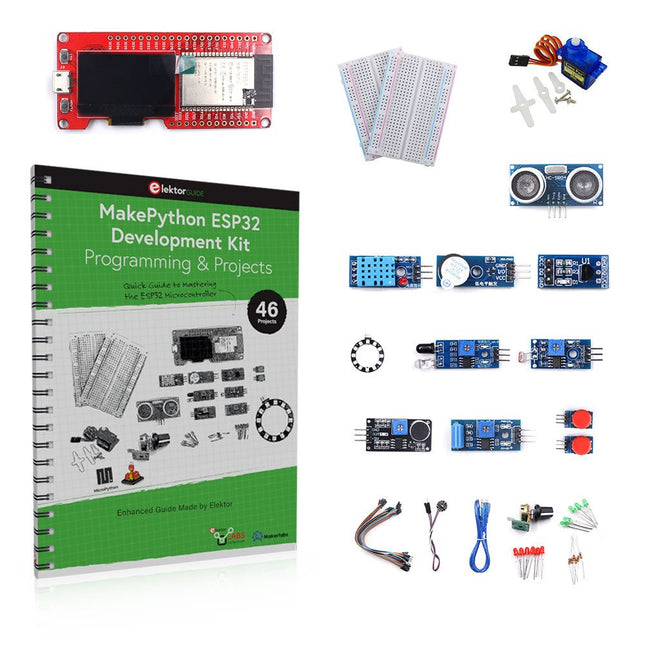
Elektor Bundles MakePython ESP32 Development Kit
Learn how to use the ESP32 Microcontroller and MicroPython programming in your future projects! The project book, written by well-known Elektor author Dogan Ibrahim, holds many software- and hardware-based projects especially developed for the MakePython ESP32 Development Kit. The kit comes with several LEDs, sensors, and actuators. The kit will help you acquire the basic knowledge to create IoT projects. The book’s fully evaluated projects feature all the supplied components. Each project includes a block diagram, a circuit diagram, a full program listing, and a complete program description. Included in the kit 1x MakePython ESP32 development board with LCD 1x Ultrasonic ranging module 1x Temperature and humidity sensor 1x Buzzer module 1x DS18B20 module 1x Infrared module 1x Potentiometer 1x WS2812 module 1x Sound sensor 1x Vibration sensor 1x Photosensitive resistance module 1x Pulse sensor 1x Servo motor 1x USB cable 2x Button 2x Breadboard 45x Jumper wire 10x Resistor 330R 10x LED (Red) 10x LED (Green) 1x Project book (206 pages) 46 Projects in the Book LED Projects Blinking LED Flashing SOS Blinking LED – using a timer Alternately flashing LEDs Button control Changing the LED flashing rate using pushbutton interrupts Chasing-LEDs Binary-counting LEDs Christmas lights (random-flashing 8 LEDs) Electronic dice Lucky day of the week Pulsewidth Modulation (PWM) Projects Generate a 1000-Hz PWM waveform with 50% duty cycle LED brightness control Measuring the frequency and duty cycle of a PWM waveform Melody maker Simple electronic organ Servo motor control Servo motor DS18B20 thermometer Analog To Digital Converter (ADC) Projects Voltmeter Plotting the analog input voltage ESP32 internal temperature sensor Ohmmeter Photosensitive resistance module Digital To Analog Converter (DAC) Projects Generating fixed voltages Generating a sawtooth-wave signal Generating a triangular-wave signal Arbitrary periodic waveform Generating a sinewave signal Generating accurate sinewave signal using timer interrupts Using The OLED Display Seconds counter Event counter DS18B20 OLED based digital thermometer ON-OFF temperature controller Measuring the temperature and humidity Ultrasonic distance measurement Height of a person (stadiometer) Heart rate (pulse) measurement Other Sensors Supplied with the Kit Theft alarm Sound-activated light Infrared obstacle avoidance with buzzer WS2812 RGB LED ring Timestamping temperature and humidity readings Network Programming Wi-Fi scanner Remote control from the Internet browser (using a smartphone or PC) – Web Server Storing temperature and humidity data in the Cloud Low-Power Operation Using a timer to wake up the processor
-

Makerfabs Makerfabs 4G LTE Hat for Raspberry Pi
Use your Raspberry Pi with LTE Cat-4 4G/3G/2G Communication & GNSS Positioning, for remote data transmission/phone/SMS, suitable for remote area monitoring/alarming. This 4G hat is based on the Maduino Zero 4G LTE, but without any controller. It needs to work with Raspberry Pi (2x20 connector and USB). The Raspberry communicate with this HAT with simple AT commands (via the TX/RX Pins in the 2X20 connector) for simple controls, such as SMS/Phone/GNSS; with the USB connecting and proper Linux driver installed, the 4G hat act as a 4G network adapter, that can access to the Internet and transmit data with 4G protocol. Compares to normal USB 4G dongle, this Raspberry Pi 4G Hat has the following advantages: Onboard Audio codec, that you can have a call directly with your RPI, or auto broadcasting with a loudspeaker; Hardware UART communication, hardware controlling of Power(by 2s pulse of PI GPIO or POWERKEY button), hardware controlling of flight mode; Dual LTE 4G antenna, plus GPS antenna Features LTE Cat-4, with uplink rate 50 Mbps and downlink rate 150 Mbps GNSS Positioning Audio Driver NAU8810 Supports dial-up, phone, SMS, TCP, UDP, DTMF, HTTP, FTP, and so on Supports GPS, BeiDou, Glonass, LBS base station positioning SIM card slot, supports 1.8V/3V SIM card Onboard audio jack and audio decoder for making a telephone call 2x LED indicators, easy to monitor the working status Supports SIM application toolkit: SAT Class 3, GSM 11.14 Release 99, USAT Included 1x 4G LTE Hat For Raspberry Pi 1x GPS antenna 2x 4G LTE antenna 2x Standoff Downloads GitHub
€ 99,95€ 49,95
Members identical
-
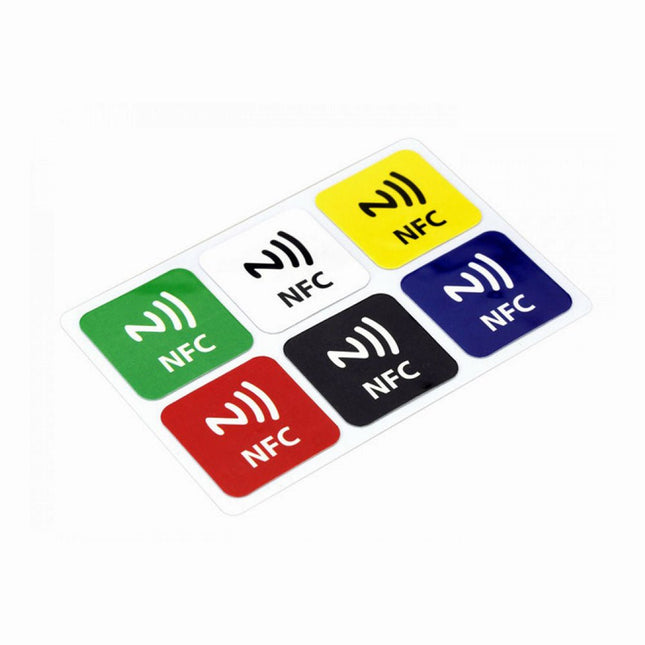
Makerfabs Makerfabs NFC Stickers (6 pcs)
Features NFC chip material: PET + Etching antenna Chip: NTAG216 (compatible with all NFC phones) Frequency: 13.56 MHz (High Frequency) Reading time: 1 - 2 ms Storage capacity: 888 bytes Read and write times: > 100,000 times Reading distance: 0 - 5 mm Data retention: > 10 years NFC chip size: Diameter 30 mm Non-contact, no friction, the failure rate is small, low maintenance costs Read rate, verification speed, which can effectively save time and improve efficiency Waterproof, dustproof, anti-vibration No power comes with an antenna, embedded encryption control logic, and communication logic circuit Included 1x NFC Stickers (6-color kit)
€ 9,95€ 4,95
Members identical
-
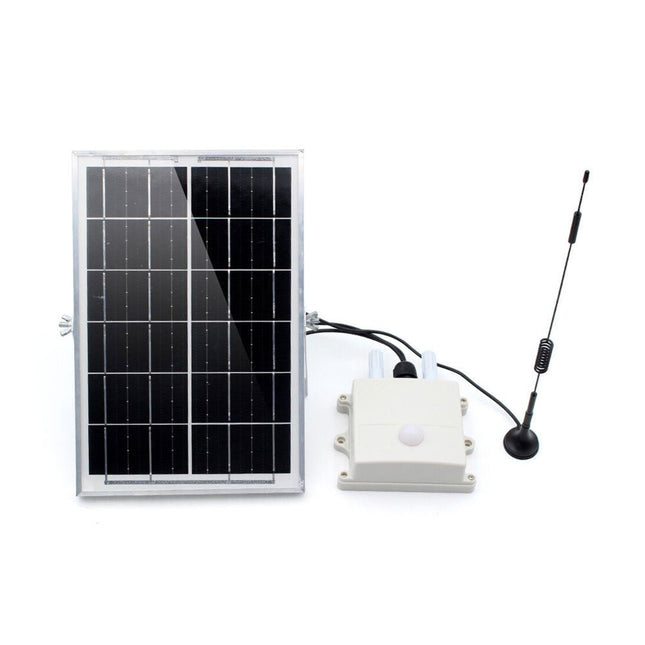
Makerfabs Makerfabs SenseLoRa Industrial-grade Air Monitor (EU868)
This air monitor is specifically used for monitoring greenhouses. It detects: Air temperature & Humidity CO2 concentration Light intensity Then transmit the data via LoRa P2P to the LoRa receiver (on your desk in the room) so that the user can monitor the field status or have it recorded for long-term analysis. This module monitors the greenhouse field status and sends all sensor data regularly via LoRa P2P in Jason format. This LoRa signal can be received by the Makerfabs LoRa receiver and thus displayed/recorded/analyzed on the PC. The monitoring name/data cycle can be set with a phone, so it can be easily implemented into the file. This air monitor is powered by an internal LiPo battery charged by a solar panel and can be used for at least 1 year with the default setting (cycle 1 hour). Features ESP32S3 module onboard with the WiFi and Bluetooth Ready to use: Power it on directly to use Module name/signal interval settable easily by phone IP68 water-proof Temperature: -40°C~80°C, ±0.3 Humidity: 0~100% moisture CO2: 0~1000 ppm Light intensity: 1-65535 lx Communication distance: Lora: >3 km 1000 mAh battery, charger IC onboard Solar panel 6 W, ensure system works Downloads Manual BH1750 Datasheet SGP30 Datasheet
€ 69,95€ 34,95
Members identical
-

STAEDTLER Markers for the EggBot (Pack of 6)
Features Universal pen for use on almost all surfaces Suitable for overhead projection Also suitable for use on CDs/DVDs Excellent smudge-proof and waterproof qualities on almost all surfaces Dries in seconds, therefore ideal for left-handed users Permanent, low-odour ink Lightfast colours: black, brown Weatherproof colour black Stand-up STAEDTLER box PP barrel and cap guarantee long service life DRY SAFE – can be left uncapped for days without drying up (Standard atmosphere according to ISO 554) Airplane-safe - automatic pressure equalization prevents pen from leaking on board aircraft Xylene and toluene-free ink Superb colour brilliancy Line width superfine approx. 0.4 mm Refillable
€ 10,95€ 5,50
Members identical
-
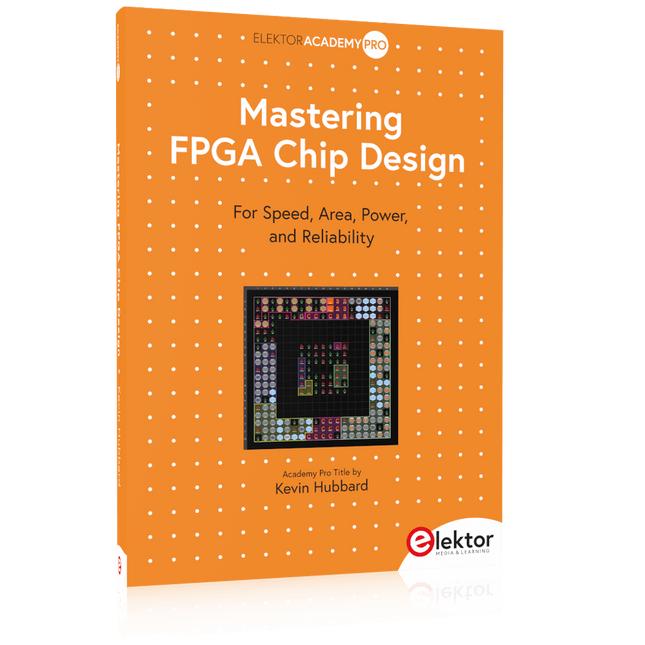
Elektor Publishing Mastering FPGA Chip Design
For Speed, Area, Power, and Reliability This book teaches the fundamentals of FPGA operation, covering basic CMOS transistor theory to designing digital FPGA chips using LUTs, flip-flops, and embedded memories. Ideal for electrical engineers aiming to design large digital chips using FPGA technology. Discover: The inner workings of FPGA architecture and functionality. Hardware Description Languages (HDL) like Verilog and VHDL. The EDA tool flow for converting HDL source into a functional FPGA chip design. Insider tips for reliable, low power, and high performance FPGA designs. Example designs include: Computer-to-FPGA UART serial communication. An open-source Sump3 logic analyzer implementation. A fully functional graphics controller. What you need: Digilent BASYS3 or similar FPGA eval board with an AMD/Xilinx FPGA. Vivado EDA tool suite (available for download from AMD website free of charge). Project source files available from author’s GitHub site.
€ 39,95
Members € 35,96
-
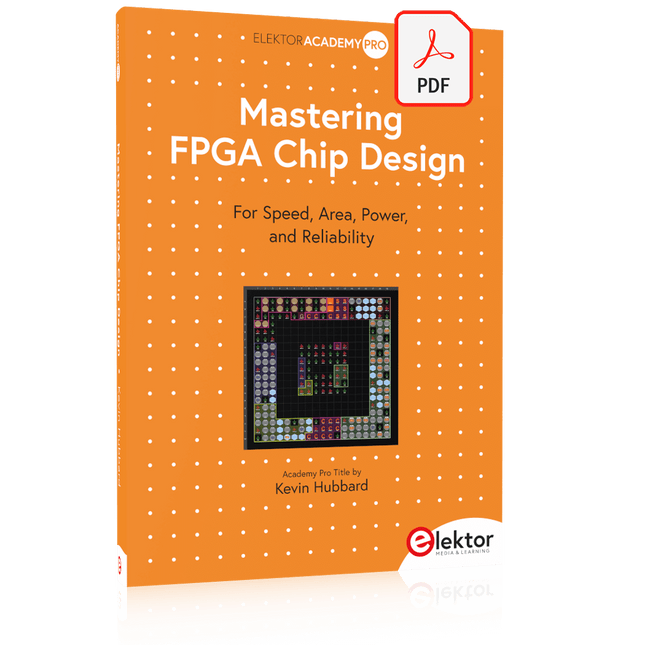
Elektor Digital Mastering FPGA Chip Design (E-book)
For Speed, Area, Power, and Reliability This book teaches the fundamentals of FPGA operation, covering basic CMOS transistor theory to designing digital FPGA chips using LUTs, flip-flops, and embedded memories. Ideal for electrical engineers aiming to design large digital chips using FPGA technology. Discover: The inner workings of FPGA architecture and functionality. Hardware Description Languages (HDL) like Verilog and VHDL. The EDA tool flow for converting HDL source into a functional FPGA chip design. Insider tips for reliable, low power, and high performance FPGA designs. Example designs include: Computer-to-FPGA UART serial communication. An open-source Sump3 logic analyzer implementation. A fully functional graphics controller. What you need: Digilent BASYS3 or similar FPGA eval board with an AMD/Xilinx FPGA. Vivado EDA tool suite (available for download from AMD website free of charge). Project source files available from author’s GitHub site.
€ 32,95
Members € 26,36























